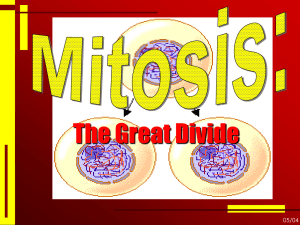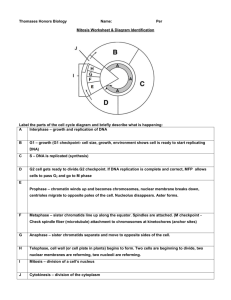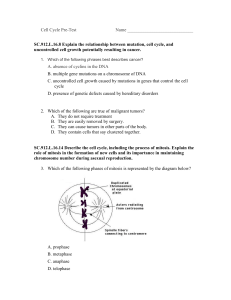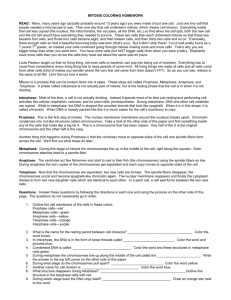Q1. (a) Give one process which occurs in the nucleus of a cell during
advertisement
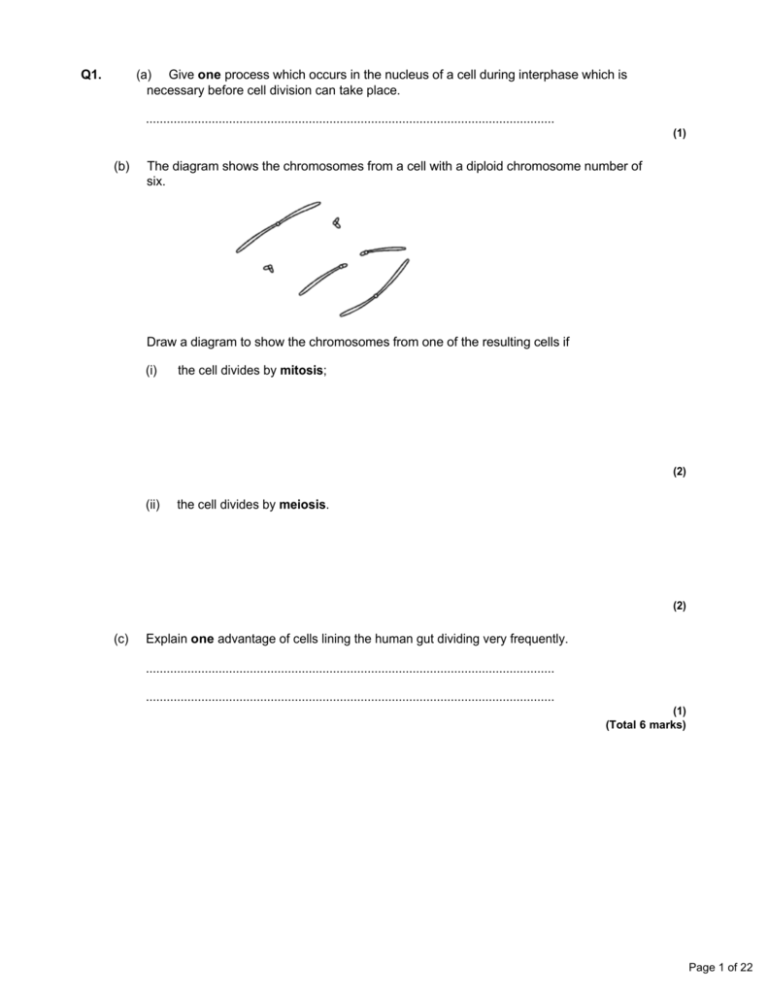
Q1. (a) Give one process which occurs in the nucleus of a cell during interphase which is necessary before cell division can take place. ...................................................................................................................... (1) (b) The diagram shows the chromosomes from a cell with a diploid chromosome number of six. Draw a diagram to show the chromosomes from one of the resulting cells if (i) the cell divides by mitosis; (2) (ii) the cell divides by meiosis. (2) (c) Explain one advantage of cells lining the human gut dividing very frequently. ...................................................................................................................... ...................................................................................................................... (1) (Total 6 marks) Page 1 of 22 Q2. The photograph shows cells from an onion root tip. The root tip has been squashed and stained to show the stages of mitosis. (a) (i) At what stage of mitosis is cell A? ............................................................................................................. (1) (ii) What is the evidence that cell B is in anaphase? ............................................................................................................. ............................................................................................................. (1) (iii) Cell C is in interphase. Give two processes which occur during interphase that enable cell division to occur. 1 .......................................................................................................... ............................................................................................................. 2 .......................................................................................................... ............................................................................................................. (2) (b) Explain how you would calculate the magnification of the photograph. ...................................................................................................................... ...................................................................................................................... (1) Page 2 of 22 (c) The number of cells at each stage of mitosis was counted. The results are shown in the table. Stage of mitosis Number of cells Interphase 123 Prophase 32 Metaphase 12 Anaphase 6 Telophase 27 One complete cell cycle takes 24 hours. The number of cells at each stage is proportional to the time spent at that stage. Calculate the length of time spent in metaphase. Show your working. Answer ........................................................... hours (2) (Total 7 marks) Q3. A student investigated the stages of mitosis in a garlic root. The root tip was placed on a microscope slide with a stain. A cover slip was placed on top and the root tip was firmly squashed. (a) Explain why (i) a root tip was used; ............................................................................................................. ............................................................................................................. (1) (ii) a stain was used; ............................................................................................................. ............................................................................................................. (1) Page 3 of 22 (iii) the root tip was firmly squashed. ............................................................................................................. ............................................................................................................. (1) (b) The student examined the cells in the garlic root tip under the microscope, and obtained the following data. Stage (i) Number of cells Interphase 872 Prophase 74 Metaphase 18 Anaphase 10 Telophase 8 Calculate the percentage of these cells in which the chromosomes are visible and would consist of a pair of chromatids joined together. Show your working. Answer ......................................... (2) (ii) A different set of results was obtained when the count was repeated on another occasion with a different garlic root tip. Give two reasons for the difference in results. 1 .......................................................................................................... ............................................................................................................. 2 .......................................................................................................... ............................................................................................................. (2) (Total 7 marks) Q4. (a) In which phase of the cell cycle does DNA replication take place? ...................................................................................................................... (1) Page 4 of 22 (b) The diagrams show five stages of mitosis. List the stages A to E in the correct sequence, beginning with the earliest stage. ..................... ..................... ..................... ..................... ..................... (1) (c) Describe the role of the spindle during mitosis. ...................................................................................................................... ...................................................................................................................... ...................................................................................................................... ...................................................................................................................... (2) (d) Meiosis also occurs during the life cycle of organisms. What is the importance of meiosis? ...................................................................................................................... ...................................................................................................................... ...................................................................................................................... ...................................................................................................................... (2) (Total 6 marks) Page 5 of 22 Q5. (a) Nucleus A and nucleus B come from the same organism. The diagram shows these nuclei immediately before division and the nuclei formed immediately after their division. The table gives information about some of the nuclei shown in the diagram. Nucleus Number of chromosomes Mass of DNA / arbitrary units A 8 600 B 8 600 C D Complete the table for nuclei C and D. (2) (b) A student investigated the process of meiosis by observing cells on a microscope slide. The cells on the slide had been stained. (i) Name an organ from which the cells may have been obtained. ............................................................................................................. (1) (ii) Explain why a stain was used. ............................................................................................................. ............................................................................................................. (1) (Total 4 marks) Page 6 of 22 Q6. (a) (i) Boxes A to E show some of the events of the cell cycle. A Chromatids separate. B Nuclear envelope disappears C Cytoplasm divides D Chromosomes condense and become visible E Chromosomes on the equator of the spindle List these events in the correct order starting with D. .......D....... ................. ................. ................. ................. (1) (ii) Name the stage described in box E. ............................................................................................................. (1) (b) Name the stage of the cell cycle during which DNA replication occurs. ...................................................................................................................... (1) Page 7 of 22 (c) Scientists produced a model to show how chemotherapy works in the treatment of cancer. The model is shown in the diagram. (i) Explain the difference in curves A and B before chemotherapy starts. ............................................................................................................. ............................................................................................................. ............................................................................................................. ............................................................................................................. (2) (ii) Chemotherapy drugs must be given a number of times if the treatment is to be successful. Use the diagram to explain why. ............................................................................................................. ............................................................................................................. ............................................................................................................. ............................................................................................................. (2) (Total 7 marks) Page 8 of 22 Q7. (a) Mitosis is important in the life of an organism. Give two reasons why. ........................................................................................................................ ........................................................................................................................ ........................................................................................................................ ........................................................................................................................ ........................................................................................................................ (2) A biologist used a microscope to investigate plant tissue where some of the cells were dividing by mitosis. She examined 200 cells and counted the number of cells in interphase and in each stage of mitosis. The table shows some of the cells she saw, and the percentage of cells in interphase and in two stages of mitosis, A and B. Stage of cell cycle Percentage of cells Interphase 90 Stage A 3 Stage B 1 Images by Edmund Beecher Wilson [Public domain], via Wikimedia Commons (b) (i) Explain why the biologist chose to examine 200 cells. ............................................................................................................... ............................................................................................................... ............................................................................................................... (1) Page 9 of 22 (ii) Name Stage A and Stage B. Give the evidence from the photograph that you used to identify the stage. Name of Stage A ................................................................................... Evidence ............................................................................................... ............................................................................................................... Name of Stage B ................................................................................... Evidence ............................................................................................... ............................................................................................................... (4) (c) In this tissue one complete cell cycle took 20 hours. Using information from the table, calculate the mean time for these cells to complete mitosis. Show your working. Answer ...................................... (2) (Total 9 marks) Q8. Yeast is a single-celled eukaryotic organism. When yeast cells are grown, each cell forms a bud. This bud grows into a new cell. This allows yeast to multiply because the parent cell is still alive and the new cell has been formed. Scientists grew yeast cells in a culture. They counted the number of cells present and measured the total concentration of DNA in the culture over a period of 6 hours. Their results are shown in the graph. Page 10 of 22 (a) Use your knowledge of the cell cycle to explain the shape of the curve for the number of yeast cells (i) between 1 and 2 hours ............................................................................................................. ............................................................................................................. (1) (ii) between 3 and 4 hours. ............................................................................................................. ............................................................................................................. (1) (b) Use the curve for the concentration of DNA to find the length of a cell cycle in these yeast cells. Explain how you arrived at your answer. Length of cell cycle ...................................................................................... Explanation .................................................................................................. ...................................................................................................................... ...................................................................................................................... ...................................................................................................................... (3) (Total 5 marks) Q9. (a) The diagram shows part of a DNA molecule. In the space below, draw a similar diagram to show this part of the molecule after it has replicated. Label the original strands and the new strands. (2) Page 11 of 22 (b) Biologists found the mean mass of DNA in three different types of cells from different animals. Their results are shown in the table. Mass of DNA in nucleus/picograms Animal (i) Liver cell Blood cell Sperm cell Chicken 2.53 2.51 1.26 Goldfish 3.29 3.28 1.64 Trout 5.79 5.78 2.89 Toad 7.33 7.31 3.68 What would you expect to be the mean mass of DNA in a skin cell from a toad? Explain your answer. ............................................................................................................. ............................................................................................................. ............................................................................................................. ............................................................................................................. (2) (ii) A zygote is formed when a sperm cell fertilises an egg cell. How much DNA would you expect to find in a trout zygote that had just been formed? Explain your answer. ............................................................................................................. ............................................................................................................. ............................................................................................................. ............................................................................................................. (2) (Total 6 marks) Page 12 of 22 Q10. The diagram shows a cell cycle. (a) The table shows the number of chromosomes and the mass of DNA in different nuclei. All the nuclei come from the same animal. Complete this table. Nucleus At prophase of mitosis Number of chromosomes Mass of DNA / arbitrary units 26 60 At telophase of mitosis From a sperm cell (4) (b) If the DNA of the cell is damaged, a protein called p53 stops the cell cycle. Mutation in the gene for p53 could cause cancer to develop. Explain how. ...................................................................................................................... ...................................................................................................................... ...................................................................................................................... ...................................................................................................................... ...................................................................................................................... ...................................................................................................................... (3) Page 13 of 22 (c) Drugs are used to treat cancer. At what phase in the cell cycle would each of the following drugs act? (i) A drug that prevents DNA replication ............................................................................................................. (1) (ii) A drug that prevents spindle fibres shortening ............................................................................................................. (1) (Total 9 marks) Q11. (a) The diagram shows a stage of mitosis in an animal cell. (i) Name this stage. ............................................................................................................... (1) (ii) Describe what happens during this stage that results in the production of two genetically identical cells. ............................................................................................................... ............................................................................................................... ............................................................................................................... ............................................................................................................... ............................................................................................................... (2) Page 14 of 22 (b) A sample of epithelial tissue from the small intestine of an animal was analysed. Some of the cells had 8.4 units of DNA, others had only 4.2 units. (i) Use your knowledge of the cell cycle to explain why some cells had 8.4 units of DNA and others had only 4.2 units. ............................................................................................................... ............................................................................................................... ............................................................................................................... ............................................................................................................... ............................................................................................................... (2) (ii) How many units of DNA would you expect to be present in a gamete formed in this animal as a result of meiosis? (1) (Total 6 marks) Page 15 of 22 M1. (a) replication / duplication / doubling of chromosomes / replication of DNA / transcription of DNA; 1 (b) (i) cell to show correct number of chromosomes; correct shape and position of centromere; 2 (ii) as (i) except everything halved – Ignore crossing over; (if mitosis and meiosis reversed, allow 1 if otherwise correct) 2 (c) to replace cells; 1 [6] M2. (a) (i) Prophase; 1 (ii) Chromosomes/chromatids moved apart; 1 (iii) A wide range of processes occurs during interphase. This list is by no means exhaustive, but we would expect to see answer such as: Increase in volume of cell/volume of cytoplasm / increase in mass / cell bigger; increase in number of organelles; synthesis of protein/named protein; DNA replication/increase / chromosomes copied; ATP synthesis / respiration; max 2 (b) Divide real length of bar (in mm)/10 by 0.02; 1 (c) 12/200 × 24 / single error in otherwise correct method; 1.44 hours (1 hour 26 min); 2 [7] M3. (a) (i) where mitosis/division/growing/ occurs (reject growing cells) 1 (ii) to distinguish chromosomes/chromosomes not visible without stain; 1 (iii) to let light through/thin layer; 1 Page 16 of 22 (b) (i) 74 + 18/982; = 9.4% / 9%; 2 (allow 1 mark for identifying prophase & metaphase i.e.92 or correct method using wrong figures) (ii) genetic differences/different types of garlic; time of day; chance; age of root tip; water availability; temperature; nutrient availability; (environmental factors = 1 but cannot be awarded in addition to a named environmental factor) 2 max [7] M4. (a) Interphase/S-phase; 1 (b) A D C E B; 1 (c) Attachment of centromeres/chromosomes/chromatids; Separation of centromeres/chromatids/chromosomes; 2 (d) Halves chromosome number/haploid; Diploid/full number restored at fertilisation; Allow correct reference to variation max 2 [6] M5. (a) Chromosomes: DNA: C = 8 and D = 4; C = 300 and D = 150; 2 (b) (i) testis / ovary; accept anther / carpel / stamen / testicle 1 (ii) to make chromosomes / chromatids / DNA / genetic material visible; 1 [4] Page 17 of 22 M6. (a) (i) (D) B E A C; 1 (ii) Metaphase; 1 (b) Interphase/S phase; 1 (c) (i) Healthy cells not dividing so number stays constant; Cancer cells dividing (uncontrollably) so increasing in number; 2 (ii) Drug only kills some cancer cells; These continue to divide; 2 [7] M7. (a) 1. Growth / increase in cell number; Ignore growth of cells 2. Replace cells / repair tissue / organs /body; Ignore repair cells Reject bacteria 3. Genetically identical cells; 3. ‘Produces 2 genetically identical cells’ does not reach MP1 as well as MP3 4. Asexual reproduction / cloning; 4. Allow example or description 2 max (b) (i) (Ensures) representative (sample); Accept find some cells in mitosis / not in interphase. Accept ‘more reliable’ only if linked to percentage (of cells).‘Improves reliability’ on its own does not gain this mark Neutral: Large sample 1 (ii) 1. A = metaphase; 2. Chromosome / chromatids lie on equator; 2. Reject homologous chromosomes Allow centre / middle 3. B = anaphase; 4. Chromatids / chromosomes separating / moving apart / moving to poles; 4. Reject homologous chromosomes 4 Page 18 of 22 (c) 2 hours / 120 minutes; Allow 1 mark if working shows candidate understood that mitosis would take 10% 2 [9] M8. (a) (i) Cells are in interphase; Accept G phase/S phase. 1 (ii) Cells undergoing mitosis/in telophase/cytokinesis; Accept all named stages but reject prophase, metaphase or anaphase on their own. 1 (b) 1. 3 hours; 2. Time between beginnings/endings DNA replication/Increases/levelling outs of DNA concentration/for shape (of curve for replication) to be repeated; 3. (DNA) replication takes place once per cell cycle; Allow close approximation where candidate attempts to be more accurate. Principle What is shown on the graph 3 [5] M9. (a) Diagram showing two identical molecules; Each with one original and one new strand; 2 (b) (i) 7.31 – 7.36; Same as liver cell/blood cell/twice sperm cell; 2 (ii) 5.78; Sperm cell + egg cell, both with 2.89/twice sperm cell; 2 [6] Page 19 of 22 M10. (a) Number of chromosomes Mass of DNA/arbitrary units At telophase of mitosis 26; 30; From a sperm cell 13; 15; Nucleus 4 (b) Cancer cells often have faulty/damaged DNA; Protein/p53 faulty/not made; Cell (with faulty /DNA) divides/completes cell cycle; Uncontrolled division produces cancer; p53 refers to the protein so do not accept reference to p53 mutating. 3 (c) (i) Interphase/S phase/synthesis phase; 1 (ii) Anaphase/A; 1 [9] M11. (a) (i) Anaphase 1 (ii) 1. Sister / identical chromatids / identical chromosomes; 1. Reject: Homologous chromosomes separate. 1. Allow any reference to chromatids / chromosomes being identical e.g. same DNA 2. To (opposite) poles / ends / sides; 2 (b) (i) 1. 8.4 / cells with twice DNA content = replicated DNA / late interphase / prophase / metaphase / anaphase; 1. Any reference to interphase must suggest towards end of interphase. 1. ‘Chromosomes replicate’ is not enough for DNA replicates. 2. 4.2 = DNA not replicated / (early) interphase / telophase / cell just divided / finished mitosis; 2 Page 20 of 22 (ii) 2.1; 1 [6] Page 21 of 22 Page 22 of 22




